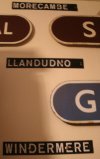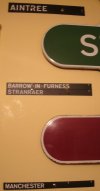ryan125hst
Established Member
I found the following photo of a split flap departure board at Edinburgh Waverley, dating to 1989: https://www.flickr.com/photos/66289212@N07/32762905665
It has made me curious as to how it dealt with all the calling patterns for all the different services. Clearly the time and platform number would be easy, and likewise the Sprinter, Intercity 125, Outer Circle etc. displays would be easy to arrange, as would the row at the bottom detailing the available catering. But calling patterns can be vary varied.
Take the Intercity 125 service to London Kings Cross as an example. It is shown as calling at Berwick, Newcastle, Durham, Darlington, Doncaster, Newark and Peterborough. The top flap would need to additionally display Alnmouth and Morpeth should the train call there as well, with or without Berwick as appropriate. Dunbar then adds an extra combination to the mix. You would need another flap on the York line to add a Northallerton call, but Retford could easily be added on the blank line, and both Grantham and Stevange could be added with an additional flap on the Newark and Peterborough lines respectively.
However, I understand that only 40 flaps could be used for each of these. When you add all the combinations of trains on all routes served from Waverley, how did they have enough capacity to display all destinations.
As an aside, I see that the board at London Kings Cross was split between Intercity and Network South East services which would have made things a bit easier: https://www.railscot.co.uk/img/28/651/
One final question - how did they handle engineering works requring trains to be terminated short of their usual destination? It is common these days for LNER to terminate at York, Doncaster or Peterborough from Edinburgh when engineering works are on in the southern part of the East Coast Main Line. How was this dealt with back in the days of split flat departure boards?
It has made me curious as to how it dealt with all the calling patterns for all the different services. Clearly the time and platform number would be easy, and likewise the Sprinter, Intercity 125, Outer Circle etc. displays would be easy to arrange, as would the row at the bottom detailing the available catering. But calling patterns can be vary varied.
Take the Intercity 125 service to London Kings Cross as an example. It is shown as calling at Berwick, Newcastle, Durham, Darlington, Doncaster, Newark and Peterborough. The top flap would need to additionally display Alnmouth and Morpeth should the train call there as well, with or without Berwick as appropriate. Dunbar then adds an extra combination to the mix. You would need another flap on the York line to add a Northallerton call, but Retford could easily be added on the blank line, and both Grantham and Stevange could be added with an additional flap on the Newark and Peterborough lines respectively.
However, I understand that only 40 flaps could be used for each of these. When you add all the combinations of trains on all routes served from Waverley, how did they have enough capacity to display all destinations.
As an aside, I see that the board at London Kings Cross was split between Intercity and Network South East services which would have made things a bit easier: https://www.railscot.co.uk/img/28/651/
One final question - how did they handle engineering works requring trains to be terminated short of their usual destination? It is common these days for LNER to terminate at York, Doncaster or Peterborough from Edinburgh when engineering works are on in the southern part of the East Coast Main Line. How was this dealt with back in the days of split flat departure boards?



 Indeed, the Low Level departures certainly were there on the main board in the years leading up to the station's redevelopment.
Indeed, the Low Level departures certainly were there on the main board in the years leading up to the station's redevelopment.